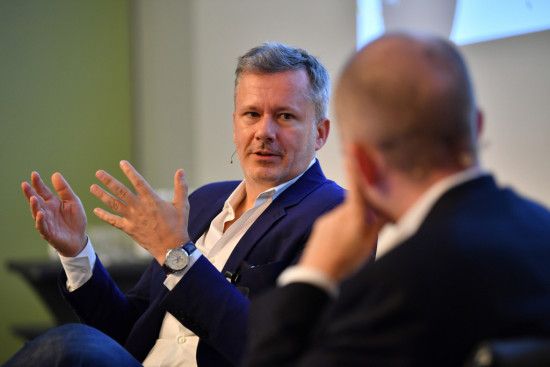Namics at the Online Marketing Rockstars 2018
Influencer marketing is all the rage. What else is exciting can you read here
Also this year a Namics delegation was at the Online Marketing Rockstars in Hamburg. I was lucky that I was part of it this year. For all of you who missed it or were too long at the fair party (which apparently is supposed to be quite decent), here is a (subjective) summary of the trends of OMR 2018.

Also this year numerous influencers were at the start. What is striking: younger and younger influencers discover the big money with influencer marketing and do not only rely on dazzling company names, but stage their own brand. For example, Sally from Sally's World (Youtube cooking and baking channel with 1'266'391 subscribers) sells kitchen accessories in her own shop. Bibi is no less successful with this tactic. The 25-year-old runs the Youtube channel Bibi's Beauty Palace with over four million followers. To monetize this reach, Bibi has developed her own shower spray: Bilou. As is well known, one can argue about taste, but the figures speak for themselves. According to her own statements, Rossmann's shower foam is said to have a market share of 27 percent of shower products.
Conclusion: It is becoming increasingly difficult for brands to successfully place their products with influencers. This makes the strategic development of own or partnered influencers as brand ambassadors all the more important.
Social Commerce – Authenticity is everything
A strikingly large number of speakers in this year's OMR edition successfully engage in social commerce. How do such business models work best? Most of the time it is companies that sell products for a certain special interest topic. Currently, this seems to work especially well for sneakers and streetwear. BSTN is one of the players who occupy this topic on social media, especially on Instagram. The channel is mainly used for brand building. Well-known testimonials are often used for this purpose, which are even free of charge due to the hip products.
What works for hip hoppers also works for bikers. The Grenzgaenger brand specializes in motocross clothing and advertises it mainly on social media. The community is clearly the focus of the marketing. The products are developed together with the community and photos are shared by fans from Grenzgaenger's official account. One of the most important lessons of Grenzgaenger: often a slightly "worse" photo from the community is more effective than a glossy photo from the marketing department.
Sweat, a paid fitness community for women, also uses this mechanism. Tobi Pearce, Founder and CEO of the company, points out some special features of social commerce. For example, a large community does not directly mean a lot of sales. It is much more important that the right target group is in the community. He sees it as a challenge to sell products via social media. The model can still be monetized, according to Sweat's own information, the company makes over 100 million Australian dollars in sales per year, with just over 100 employees. Sweat has also taken the first trend to heart and built up his own influencer, Kayla (11.9 million subscribers on Instagram). She distributes the app via her own website, only at the end the Sweat brand is brought into play.
Conclusion: Money can still be made through authenticity via social media. Or in the words of Robert Gentz, CEO of Zalando: The long tail still holds the most corporate gold nuggets.
Voice Search - the next big thing?
Which technology will prevail next was of course also discussed. From my perspective, one topic is currently particularly hot: language assistants. Scott Galloway, one of the highlights of this OMR issue, dares to make the following statement: Voice is the new battleground. Because in the future there will be only one answer to search queries. For shopping queries, this means that Google and Amazon will determine which product is suggested. In the case of Amazon, it will probably be the house brands, and with Google, Google Shooping offers will probably make it to the top.
The ladies and gentlemen from Google also showed why and how they would like to use voice for transactions in the future. The success of Yext shows that other companies are already addressing this topic. The company helps companies to maintain public figures and data about their brand online (e.g. opening hours and locations). These are especially important when using language assistants. The trend towards voice searches ensured that the company's valuation now stands at USD 1 billion after the IPO.
Conclusion: In all probability, voice assistants will become more widespread. It is therefore high time for companies to consider how they need to prepare their data so that it is also taken into account and used by voice assistants.
GAFA – no way around them?!
With regard to the general general weather situation in digital marketing, one topic in particular was dominant: GAFA. If you ask yourself what that is, it's the first letters of the four technology giants: Google, Amazon, Facebook and Apple. The problem; the four companies are now so powerful that there is practically no getting around them. As a result, they achieve a monopoly position, which they consistently play out. The experts present did not agree on how to break this supremacy. In view of the current data scandal debate about Facebook, the discussion on this issue was no less heated.
While Sven Schmitt, venture capital expert and unofficial OMR analyst, advocated intervention by politicians, other experts, such as Frank Thelen, have a more liberal attitude. Scott Galloway is hoping for a D-Day from Europe and has actively called for an uprising. But if you look at the figures, you can quickly see that the European digital industry is clearly behind the world leaders. Meanwhile, hope rests only on Zalando as a possible counterpart. But whether this will help to achieve a breakthrough or whether we will end up with GAFAZ remains open.
Conclusion: On the one hand, society and politics must be clear about how to deal with GAFA. On the other hand, every company has to consider which strategy it uses in relation to GAFA in order to benefit from it but not to become dependent on it. Furthermore, data security and the declining trust in these services play an increasingly central role.
If you have identified another point on the OMR18 or if you have a completely different opinion, you are of course welcome to express it in the comments. I look forward to a lively discussion with you.












